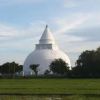තිස්සමහාරාමය
The Tissamaharama Raja Maha Vihara is a Buddhist temple in Tissamaharama, Sri Lanka. It was built in the 2nd century BC by King Kavan Tissa of Ruhuna (Southern Sri Lanka). The site was consecrated by Lord Buddha himself, who spent some time in meditation there with 500 arhats (individuals who have reached enlightenment).[1] The Tissamaharama Dagoba which is situated in the premises of Tissamaharama Raja Maha Vihara is one of the largest stupas in Sri Lanka. A stupa is a Buddhist dome-shaped religious monument found largely on the Indian subcontinent and also called a dagoba in Sri Lanka.
Tissamaharama is one of the most pleasant towns in the southern coast. The beautiful man-made tank (reservoir) in Tissa, Tissa Wewa with its remarkable bird life provides the scenic backdrop to the town. Tissa was the sanctuary in the Deep South, where Sinhalese patriots fled to rally support against marauding Dravidian invaders from Southern India. Known by the name of Mahagama (great town), it was one of the principal settlements of the southern province of Ruhuna. Mahagama was founded in the third century BC by a brother of the King Devanapiyatissa of Anuradhapura, and later raised to prominence under King Kavantissa, father of the hero of the nation, King Dutugemunu.
Tissa Maha Dagoba Most impressive is the restored Maha Stupa, built by King Kavantissa in the 3rd century BCE located between Tissa town centre and the tank. It was the largest Dagoba in the island at the time. Today, for Buddhist pilgrims, it is one of the sixteen most sacred sites (Solosmasthana) in the country. The Dagoba has a circumference of 165m & stands 55.8m in height, is enshrined with Sacred Tooth Relic and Forehead Bone Relic of the Buddha. Next to the Dagoba is a statue of Queen Vihara Maha Devi, the heroine of the nation and Queen of King Kavantissa and the mother of the hero, King Dutugemunu.
Sandagiri Dagoba is nearby, together with the remains of a monastery complex. A walk around the Dagoba provides us with an insight into the construction of the great Dagobas. Sandagiri (or Santagiri) Dagoba, too was built by Kavantissa and now restored to its original glory.
Yatala Dagoba by the Tissa-Deberawewa road is Yatala Vehera, built 2300 years ago by King Yatalathissa with its surrounding wall of sculpted elephant heads and moat and large moonstone. There is also a large monolith with scorings on one face that are believed to have been made by chains used to tether royal elephants.
Menik Dagoba when we continue down the road for a couple of hundred meters to reach the Menik Dagoba.
Ruins of Galkanumandiya; The small cluster of pillars you pass en route is all that remains of the Galkanumandiya, thought to be some kind of monastic building.
Sithulpawwa, an ancient site of historical, archaeological and religious importance, built by King Kavantissa is situated within the Yala National Park. During the King's reign there had been 12,000 monks dwelling





